Archive:EU-ASEAN cooperation - key trade and investment statistics
This Statistics Explained article is outdated and has been archived - for recent articles on non-EU countries see here.
Data extracted in March and April 2017.
No update planned for this article.
Highlights
Within ASEAN, the largest trader of goods in 2015 was Singapore, with exports to all countries of the world valued at EUR 330 billion and imports at EUR 267 billion.
This article is part of a set of statistical articles based on Eurostat’s publication 40 Years of EU–ASEAN Cooperation — Key statistics. It provides a selection of statistics on the European Union (EU) and its Member States in comparison with the Association of Southeast Asian Nations (ASEAN) and its Member States and focuses on international trade and foreign direct investment.
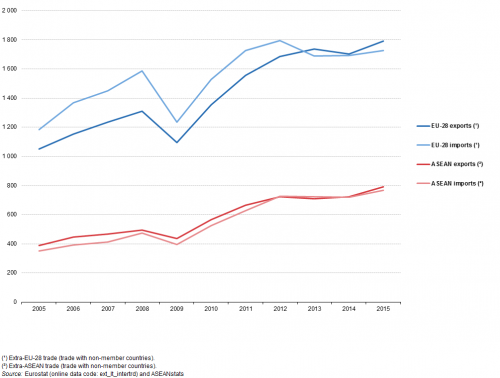
(billion EUR)
Source: Eurostat (ext_lt_intertrd) and ASEANstats
Full article
International trade in goods
The total value of the goods exported from the EU-28 to the rest of the world (outside of the EU) in 2015 was EUR 1.79 trillion (EUR 1.79 thousand billion), 71 % higher than its level in 2005 (see Figure 1). Imports rose at a slower pace, up 46 % to EUR 1.73 trillion, such that a trade deficit in goods between 2005 and 2012 turned into a surplus between 2013 and 2015. There was an even faster development to international trade flows for ASEAN (with partners outside of ASEAN), as exports and imports more than doubled between 2005 and 2015. The slightly faster increase in imports resulted in the trade surplus narrowing over this period and ASEAN reported an almost balanced position for trade in goods in 2012 and 2014. ASEAN’s international exports and imports of goods in 2015 were valued at just under EUR 800 billion, equivalent to 44 % of the equivalent values for the EU-28.

(billion EUR)
Source: Eurostat (ext_lt_intertrd) and ASEANstats
Within ASEAN, the largest trader of goods in 2015 was Singapore, with exports to all countries of the world valued at EUR 330 billion and imports at EUR 267 billion. Other large traders of goods were Thailand, Malaysia, Vietnam and Indonesia, all with imports and exports of goods valued in excess of EUR 100 billion. Among the EU Member States, Germany was the largest trader of goods, its exports to the world were valued at EUR 1.2 trillion in 2015 and its imports at EUR 946 billion, while the next largest exporters were the Netherlands, France, the United Kingdom, Italy and Belgium.
Six of the ASEAN Member States reported a trade surplus for goods in 2015, with that of Singapore larger than those of the other five combined. Less than half (12) of the EU Member States reported a trade surplus for goods, with the German surplus also larger than the combined value for the other Member States with surpluses.

(million EUR)
Source: Eurostat (ext_lt_intertrd) and ASEANstats
Machinery and vehicles accounted for the highest proportion of goods exported from the EU-28 in 2015, with a 42.0 % share of the total. This was considerably higher than the shares recorded for other manufactured goods (which cover SITC Sections 6 and 8) and chemicals (22.5 % and 17.6 % respectively), while each of the remaining goods categories shown in Table 2 accounted for less than 10 % of total EU-28 exports.
The Philippines, Singapore, Thailand and Malaysia also reported that machinery and vehicles accounted for the largest share of their exports, at least two fifths of the total in each case, with this share passing half in Singapore and approaching two thirds in the Philippines. Other manufactured goods accounted for more than four fifths of total exports in Cambodia and was also the largest category in Vietnam and Indonesia. In the two remaining ASEAN Member States (no data available for Lao PDR), mineral fuels, lubricants and related goods had the highest share of total exports, 93.0 % in Brunei Darussalam and 38.5 % in Myanmar (2010 data).
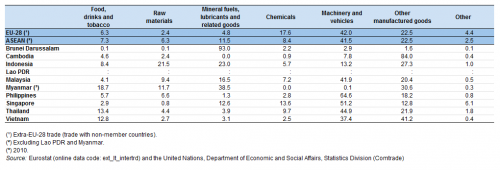
(%)
Source: Eurostat (ext_lt_intertrd) and the United Nations, Department of Economic and Social Affairs, Statistics Division (Comtrade)
Machinery and vehicles (31.0 %), other manufactured goods (26.1 %) and mineral fuels (19.0 %) accounted for the highest shares of goods imported into the EU-28 in 2015; the next most common group of imported goods was chemicals (10.7 %).
Machinery and vehicles was also the largest category of imports in seven of the nine ASEAN Member States for which data are available, accounting for upwards of 30 % of total imports; the exceptions were Cambodia and Myanmar (2010 data) where other manufactured goods was the largest category. The relative importance of mineral fuels varied quite considerably between the ASEAN Member States, accounting for a relatively low share of imports in Cambodia, Vietnam and Brunei Darussalam (much less than 10 %), but a relatively high share in Myanmar and Singapore (over 20 %).
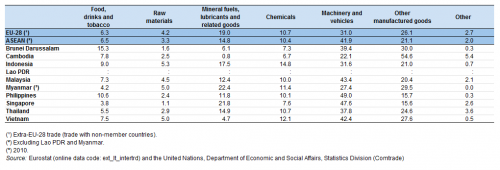
(%)
Source: Eurostat (ext_lt_intertrd) and the United Nations, Department of Economic and Social Affairs, Statistics Division (Comtrade)
Trading relations between any pair of entities are recorded both by the exporter and importer and the values recorded for a particular trade may differ for a number of reasons, including for example methodological differences: this issue affects all bilateral trade statistics, not just those between the EU and ASEAN. The data presented in Figures 2 to 6 and Table 4 all concern data reported by the EU Member States and may differ to some extent from equivalent data reported by ASEAN Member States.
In 2015, the EU-28’s exports of goods to ASEAN were valued at EUR 83 billion, up 85.8 % since 2005, while imports were valued at EUR 118 billion, an increase of 65.0 % over the same period. The share of the EU-28’s exports of goods to non-EU countries that were destined for ASEAN rose from 4.3 % in 2005 to 4.6 % by 2015, while ASEAN’s share of the EU-28’s imports of goods from non-EU countries rose from 6.1 % to 6.9 %. As such, by 2015 the EU-28’s exports of goods to ASEAN were greater in value than its exports of goods to any of its individual trading partners except for the United States, China and Switzerland, while its imports of goods from ASEAN were greater in value than its imports of goods from any of its individual trading partners except for China, the United States and Russia.
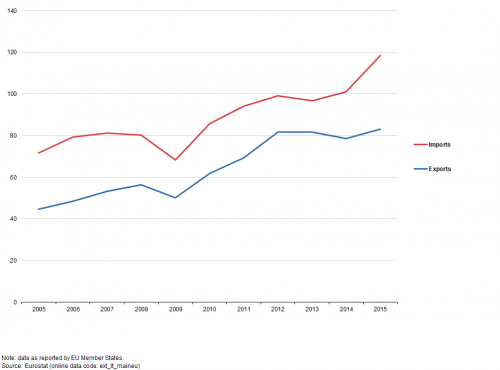
(billion EUR)
Source: Eurostat (ext_lt_maineu)
The EU-28 recorded a trade deficit for goods with ASEAN, narrowing from EUR 27.1 billion in 2005 to EUR 15.1 billion in 2013 before widening to EUR 35.4 billion in 2015.
Between 2005 and 2015 the EU-28’s trade in goods with Singapore moved from a relatively small trade deficit to a larger trade surplus, as exports increased by EUR 12.4 billion while imports increased by less than EUR 0.5 billion. In a slightly different manner the EU-28’s trade surplus for goods with Brunei Darussalam increased between these years as exports increased many times over while the comparatively low level of imports contracted.
With all other ASEAN Member States the EU-28 recorded a trade deficit for goods in both 2005 and 2015, peaking in 2015 at a deficit of EUR 21.5 billion with Vietnam. Between 2005 and 2015 the EU-28’s trade deficits with Cambodia, Malaysia, Thailand and Vietnam increased: the deficit with Vietnam increased by EUR 17.8 billion as imports from Vietnam were more than five times as high in 2015 as in 2005; the deficits with Cambodia, Malaysia and Thailand increased by EUR 3.2 billion, EUR 2.3 billion and EUR 0.9 billion respectively. During the same period the EU-28’s trade deficits for goods with Indonesia, Myanmar and the Philippines narrowed, most notably with the Philippines where it fell from EUR 2.9 billion in 2005 to EUR 0.6 billion in 2015. The EU-28’s trade deficit for goods with Lao PDR was similar in 2015 to the level it had been in 2005, just over EUR 0.1 billion.

(million EUR)
Source: Eurostat (ext_lt_maineu)
Figures 3 to 6 identify the largest partners within EU–ASEAN trade in goods. The largest exporters of goods from the EU-28 to ASEAN were Germany, France, the United Kingdom and the Netherlands (see Figure 3) while the main recipients of these exports were Singapore, Thailand, Malaysia, Indonesia and Vietnam (see Figure 4).
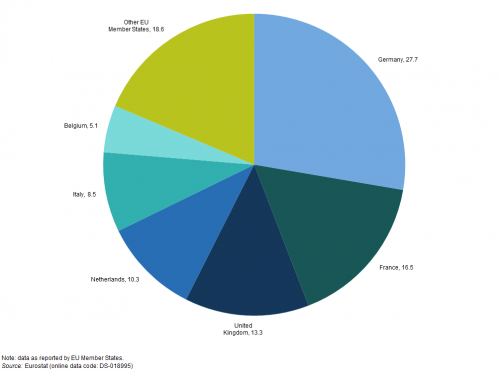
(% share of EU-28 exports to ASEAN)
Source: Eurostat (DS-018995)

(% share of EU-28 exports to ASEAN)
Source: Eurostat (ext_lt_maineu)
The same five ASEAN Member States — Vietnam, Malaysia, Thailand, Singapore and Indonesia — were also the largest exporters of goods from ASEAN to the EU-28 (see Figure 5), while the main recipients of these imports were Germany, the Netherlands and the United Kingdom (see Figure 6).
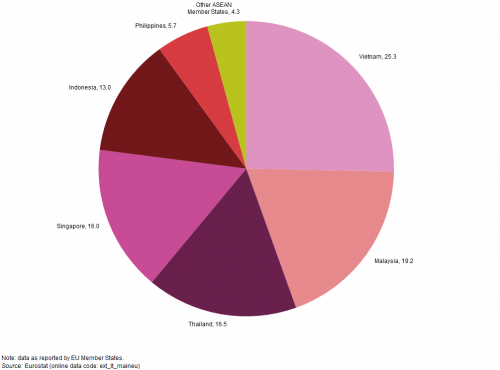
(% share of EU-28 imports from ASEAN)
Source: Eurostat (ext_lt_maineu)

(% share of EU-28 imports from ASEAN)
Source: Eurostat (DS-018995)
International trade in services
The total value of the services exported (referred to as credits in Table 5) from the EU-28 to the rest of the world (outside of the EU) in 2015 was EUR 832 billion, 46 % higher than its level in 2010. Imports (referred to as debits) rose at a similar pace, up 49 % to EUR 686 billion, such that the trade surplus in services expanded between 2010 and 2015. There was an even faster development to flows of international trade in services for ASEAN (including intra-ASEAN trade), as exports increased by 71 % and imports by 62 %, leading to a narrowing of ASEAN’s trade deficit for services. ASEAN’s international exports of services in 2015 were valued at EUR 276 billion, while imports were valued at EUR 281 billion.
As for goods, within ASEAN the largest trader of services in 2015 was Singapore, other large trading ASEAN Member States included Thailand, Malaysia, the Philippines and Indonesia. Among the EU Member States, the United Kingdom was the largest exporter of services, while Germany had the largest imports. Half of the ASEAN Member States reported a trade surplus for services in 2015, with that of Thailand larger than of the other four combined. In the EU, all but four Member States reported a trade surplus for services, with the British surplus by far the largest.
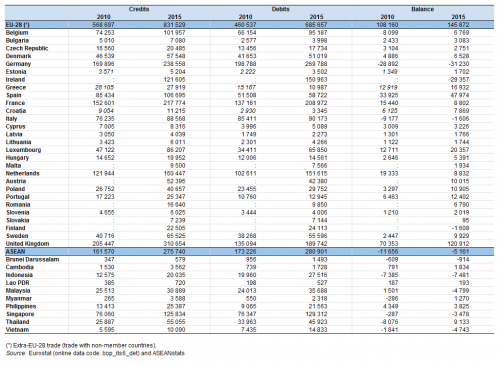
(million EUR)
Source: Eurostat (bop_its6_det) and ASEANstats
Trade with ASEAN accounted for 5.1 % of the EU-28’s exports of services to non-EU countries in 2015 (up from 4.3 % in 2010) and 5.4 % of its imports in 2015 (up from 4.9 % in 2010). The EU-28 reported a trade surplus for services with ASEAN in 2015 that was nearly three and a half times as high as it had been in 2010.
Note that the analysis by type of service presented in Table 6 is only available for the EU’s trade with five ASEAN Member States, these being the five with the highest levels of trade in services. The two services with the largest share of the total trade in services in 2015, both for exports and imports, were transport and other business services.

(million EUR)
Source: Eurostat (bop_its6_det)
Figures 7 to 10 identify the largest partners within EU–ASEAN trade in services. The largest exporters of services from the EU-28 to ASEAN were the Netherlands and the United Kingdom (see Figure 7) while Singapore was clearly the main recipient of these exports (see Figure 8).
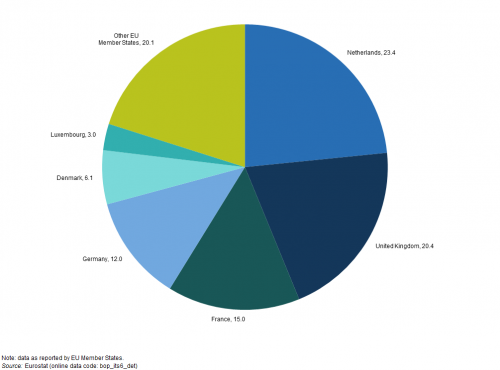
(% share of EU-28 exports to ASEAN)
Source: Eurostat (bop_its6_det)
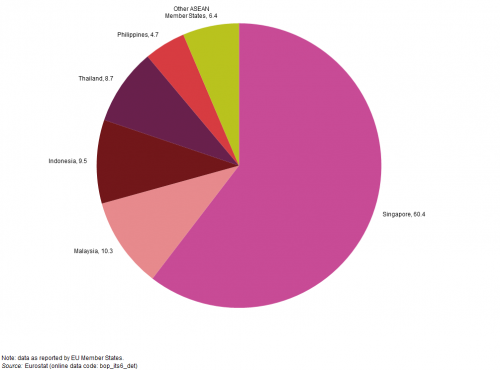
(% share of EU-28 exports to ASEAN)
Source: Eurostat (bop_its6_det)
Equally, Singapore dominated the supply of services to the EU-28 from these five ASEAN countries (see Figure 9), while the main recipients of these services imported into the EU were Germany, the United Kingdom, France and the Netherlands, followed quite closely by two of the smaller Member States, Luxembourg and Denmark (see Figure 10).
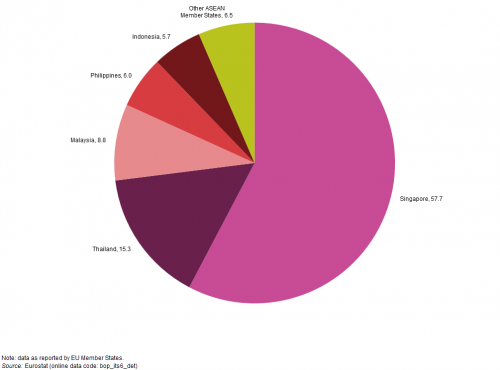
(% share of EU-28 imports from ASEAN)
Source: Eurostat (bop_its6_det)
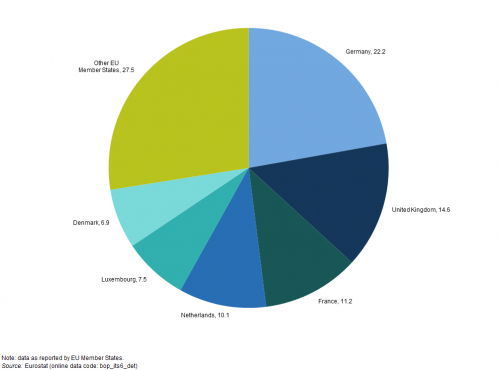
(% share of EU-28 imports from ASEAN)
Source: Eurostat (bop_its6_det)
Foreign direct investment
Foreign direct investment (FDI) concerns investment in new foreign plant or similar assets as well as the purchase of existing assets that belong to a foreign enterprise. Unlike portfolio investment, FDI involves gaining control or an effective voice in the management of the direct investment enterprise. The indicators presented in Figures 11 to 15 are averaged over the period 2013–2015 as values can vary greatly from one year to the next. Collectively, the ASEAN Member States were net recipients of FDI during these three years; this was also the case in six of the individual ASEAN Member States, the exceptions being Malaysia, Brunei Darussalam and the Philippines where net outflows were higher and Myanmar for which data on outflows are not available.
Globally, net inflows of FDI were close to 2.1 % of GDP in 2013–2015; the ASEAN Member States generally recorded higher net inflows than this, with the exception of the Philippines (where the net inflow was lower) and Indonesia (where it was in line with the global average). The EU-28 recorded slightly higher net FDI outflows (2.7 %) than net inflows (2.5 %).
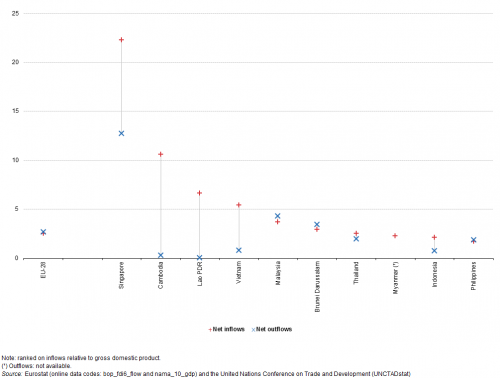
(% of gross domestic product)
Source: Eurostat (bop_fdi6_flow) and (nama_10_gdp) and the United Nations Conference on Trade and Development (UNCTADstat)
The data presented in Figures 12 to 15 come from different sources. Figures 12 and 13 show the flows of FDI from the EU-28 to ASEAN and are data reported by ASEAN Member States. Figures 14 and 15 show the flows of FDI from ASEAN to the EU-28 and are data reported by the EU Member States.
The main source of net outflows of FDI from the EU-28 to ASEAN between 2013 and 2015 were from the Netherlands, the United Kingdom and Luxembourg (see Figure 12), collectively providing nearly four fifths (79.0 %) of all EU-28 FDI to ASEAN. The vast majority of this investment was destined for Singapore (84.4 %), with a smaller share to Malaysia (9.4 %) and the remainder (less than one tenth of the total) split between the other ASEAN Member States (see Figure 13); note that a negative value was reported for Indonesia, indicating that withdrawals of investment outweighed new investment during the three year period considered.
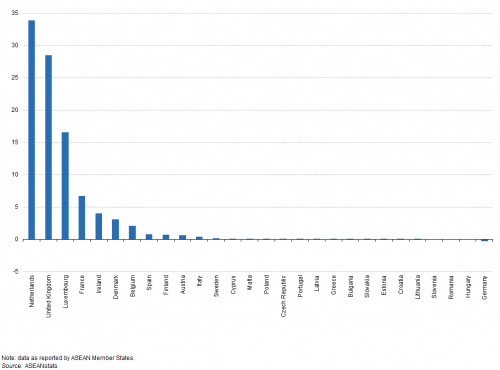
(% share of net outflows of foreign direct investment from EU-28 to ASEAN)
Source: Eurostat (bop_fdi6_flow) and (nama_10_gdp) and ASEANstats

(% share of net outflows of foreign direct investment from EU-28 to ASEAN)
Source: Eurostat (bop_fdi6_flow) and (nama_10_gdp) and ASEANstats
The main origins of net inflows of FDI to the EU-28 from ASEAN between 2013 and 2015 were also Singapore and Malaysia (see Figure 14), with small negative values reported for Brunei Darussalam, Myanmar, Vietnam and Thailand, indicating that their withdrawals of investment outweighed their new investment during these years.

(% share of net inflows of foreign direct investment from ASEAN to EU-28)
Source: Eurostat (bop_fdi6_flow)
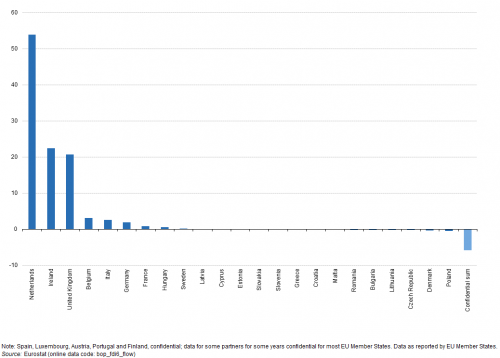
(% share of net inflows of foreign direct investment from ASEAN to EU-28)
Source: Eurostat (bop_fdi6_flow)
Source data for tables and graphs
Data sources
The indicators presented are often compiled according to international — sometimes global — standards. Although most data are based on international concepts and definitions there may be certain discrepancies in the methods used to compile the data.
All of the indicators presented for the EU and its Member States have been drawn from Eurobase, Eurostat’s online database.
For ASEAN and its Member States, the data presented have been extracted from ASEAN statistics and a range of international sources, namely the United Nations, Department of Economic and Social Affairs, Statistics Division and the United Nations Conference on Trade and Development (UNCTAD).
For many of the indicators, multiple international statistical sources are available, each with their own policies and practices concerning data management (for example, concerning data validation, the correction of errors, the estimation of missing data, and the frequency of updating). In general, attempts have been made to use only one source for each indicator in order to provide a comparable analysis between the EU Member States or between the ASEAN Member States.
Context
The EU is actively engaged with ASEAN in expanding trade and investment relations, which have intensified considerably during the last decade. The EU-28 as a single entity has become ASEAN’s second largest trade partner, after China. Meanwhile ASEAN as a single entity is the EU-28’s third largest trade partner outside Europe, after the United States and China. The EU-28 is also the largest foreign investor in ASEAN economies.
Direct access to
- 40 Years of EU-ASEAN Cooperation — Key statistics — online publication
- Asia-Europe Meeting (ASEM) — a statistical portrait — online publication
- South Korea-EU - international trade in goods statistics
- The EU in the world
- Balance of payments, see:
- Balance of payments - International transactions (BPM6) (bop_6)
- European Union direct investments (BPM6) (bop_fdi6)
- EU direct investment flows, breakdown by partner country and economic activity (BPM6) (bop_fdi6_flow)
- European Union direct investments (BPM6) (bop_fdi6)
- International trade in goods (ext_go)
- International trade in goods – aggregated data (ext_go_agg)
- International trade in goods – detailed data (detail)
- International trade in services, geographical breakdown (BPM6) (bop_its6)
- International trade in services (since 2010) (BPM6) (bop_its6_det)
- ASEM partners accounted for 44% of EU28 imports and 30% of exports in 2013 — News release October 2014
- Goods trade with ASEAN countries rebounds from 2009 to 2010 — Statistics in focus 47/2011
- The EU in the world 2013 — A statistical portrait — Statistical book (2013)